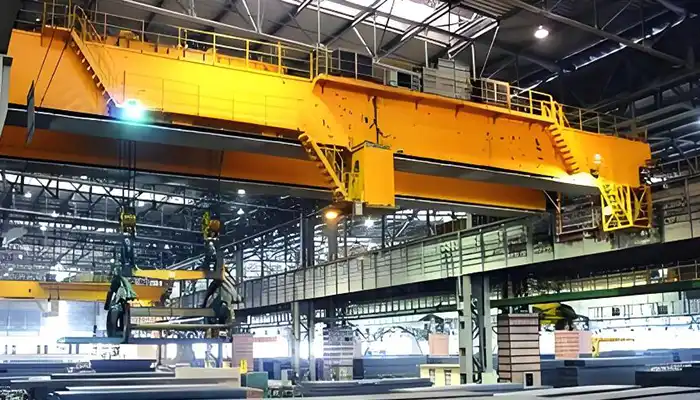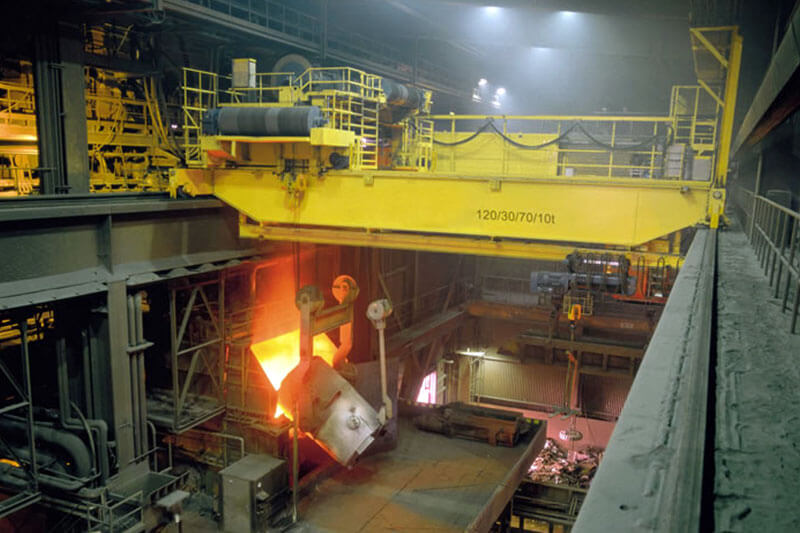Overhead Crane Design Considerations for Heavy-duty Steel Mill Operations
Maximizing Efficiency and Safety: Overhead Crane Design for Heavy-duty Steel Mills in Brazil
Overhead cranes play a pivotal role in the seamless functioning of steel mills, serving as indispensable tools for material handling and production processes. In the dynamic environment of Brazilian steel mills, where heavy-duty operations are the norm, the role of overhead cranes becomes even more critical. These cranes are not just tools; they are the backbone of operational efficiency, enabling the movement of raw materials, semi-finished products, and finished goods with precision and safety.
Brazilian steel mills operate under rigorous conditions, necessitating robust equipment capable of withstanding high loads and harsh environments. The heavy-duty requirements include the handling of massive steel coils, ingots, and other bulky materials, which demand cranes with superior load capacities and structural integrity. Moreover, the climate challenges in Brazil, such as humidity and temperature variations, pose additional considerations for crane design, requiring corrosion-resistant materials and reliable electrical systems.
In essence, optimizing overhead crane design for Brazilian steel mills involves addressing these unique operational demands while ensuring safety, efficiency, and longevity. This introduction sets the stage for exploring the specific design considerations crucial to enhancing productivity and minimizing downtime in this critical industrial sector.
Top Running Double Girder Bridge Cranes for the Steel Industry 5 Ton to 550 Ton
Environmental Considerations
Climate Challenges
In the context of Brazilian steel mills, climate challenges such as humidity and temperature variations significantly influence overhead crane design. High humidity levels can accelerate corrosion, posing a threat to structural integrity and longevity. Therefore, implementing robust corrosion-resistant measures, including coatings and materials such as stainless steel or galvanized components, becomes imperative to mitigate these effects. By safeguarding against corrosion, cranes can maintain operational efficiency and minimize maintenance downtime, ensuring continuous productivity.
Operational Conditions
Effective management of dust and debris is another critical consideration for overhead crane operations in Brazilian steel mills. These environments are prone to high levels of airborne particles generated during material handling and processing operations. Incorporating sealed electrical components and housing critical mechanisms can prevent dust ingress, thereby enhancing the reliability and lifespan of electrical systems. Furthermore, ensuring adequate ventilation and filtration systems around crane operations helps maintain optimal working conditions and reduces the risk of equipment malfunction.
Electrical system reliability is paramount in harsh industrial environments characterized by fluctuating temperatures and exposure to contaminants. Utilizing insulated wiring, encapsulated electronics, and protective enclosures for control panels are essential strategies to safeguard against environmental factors. By integrating these measures into crane design, manufacturers can enhance operational reliability, minimize downtime due to electrical failures, and uphold safety standards in Brazilian steel mill operations.
Ladle Overhead Bridge Cranes for Hot and Dusty Environment in Steel Mills
Structural Design
Load Capacities and Dynamics
When designing overhead cranes for Brazilian steel mills, calculating precise load capacities is crucial due to the heavy-duty nature of materials handled. Steel industry materials like coils and ingots vary significantly in weight and dimensions, necessitating meticulous load capacity calculations. Understanding dynamic loads, including the effects of acceleration, deceleration, and sudden stops during crane operation, is equally vital. These dynamic factors impact crane stability and structural integrity, influencing design choices such as beam strength, girder size, and support structures.
Material Selection
Selecting appropriate materials is fundamental to ensuring the durability and reliability of overhead cranes in Brazilian steel mills. Components subjected to high stresses must utilize high-strength materials such as alloy steels or specialized composites. These materials offer superior mechanical properties, including high tensile strength and fatigue resistance, essential for withstanding prolonged operational cycles without compromising safety or performance.
Resistance to fatigue and wear is critical for components exposed to repetitive loading and abrasive environments typical in steel mills. Incorporating wear-resistant coatings or using materials engineered to withstand friction and impact can extend component lifespan and reduce maintenance requirements. By prioritizing material selection based on performance characteristics, manufacturers can optimize overhead crane designs to meet the rigorous demands of Brazilian steel mill operations effectively.
Heavy duty steel mill cranes for sale , custom bridge crane with open winch trolley for sale
Safety Standards and Regulations
Brazilian Regulatory Framework
Adhering to the Brazilian regulatory framework is paramount when designing overhead cranes for steel mills. Compliance with standards set by the Brazilian Association of Technical Standards (ABNT) ensures that cranes meet local safety requirements and operational guidelines specific to the heavy-duty industrial sector. These standards encompass design criteria, structural integrity, electrical safety, and operational protocols tailored to Brazilian industrial environments.
Safety Protocols Specific to Heavy-duty Operations
In Brazilian steel mills, safety protocols are tailored to mitigate the unique risks associated with heavy-duty crane operations. These protocols emphasize regular inspections, operator training, and adherence to operational limits. Measures such as load testing, structural integrity assessments, and environmental hazard assessments ensure cranes operate safely and efficiently amidst challenging conditions.
Risk Mitigation Strategies
Effective risk mitigation strategies are integral to enhancing crane safety in Brazilian steel mills. Fall protection systems, including guardrails, harnesses, and safety nets, are essential to prevent accidents during maintenance and operation at heights. Emergency shutdown procedures, equipped with fail-safe mechanisms and remote activation capabilities, provide swift responses to potential hazards such as electrical faults or structural failures. By integrating these strategies into crane design and operational protocols, manufacturers enhance workplace safety and minimize downtime, supporting continuous production in Brazilian steel mills.
Technological Integration
Automation and Control Systems
In Brazilian steel mills, integrating advanced automation and control systems enhances overhead crane performance and operational efficiency. Remote monitoring and diagnostics allow real-time assessment of crane health and performance metrics, facilitating proactive maintenance and minimizing downtime. By leveraging these technologies, operators can optimize crane utilization and enhance overall productivity in dynamic industrial environments.
Integration with ERP Systems for Seamless Operations
Seamless integration of overhead cranes with Enterprise Resource Planning (ERP) systems is critical for streamlining operations in Brazilian steel mills. This integration enables automated data exchange between crane operations and business processes, facilitating efficient resource allocation, production scheduling, and inventory management. By aligning crane activities with broader operational strategies, manufacturers can achieve enhanced operational visibility and responsiveness to market demands.
Energy Efficiency
Promoting energy efficiency in overhead crane design is pivotal for sustainability and cost-effectiveness in Brazilian steel mills. Regenerative braking systems harness kinetic energy during crane deceleration, converting it into usable electricity and reducing overall power consumption. Incorporating LED lighting and energy-efficient components further minimizes energy usage and operational costs while maintaining optimal illumination levels and operational safety standards. These initiatives not only align with environmental regulations but also contribute to long-term operational sustainability and profitability in the steel manufacturing sector.
Maintenance and Lifecycle Management
Predictive Maintenance
Implementing predictive maintenance strategies is crucial for optimizing overhead crane reliability and performance in Brazilian steel mills. Utilizing Internet of Things (IoT) technology enables continuous condition monitoring of critical crane components. Real-time data analytics and sensor-based diagnostics facilitate early detection of potential issues, allowing for timely intervention and preventive maintenance. By adopting predictive maintenance practices, operators can minimize unplanned downtime, extend equipment lifespan, and enhance operational efficiency.
Scheduled Inspections and Maintenance Routines
Regular scheduled inspections and maintenance routines are fundamental to ensuring the operational readiness of overhead cranes in Brazilian steel mills. These proactive measures include comprehensive visual inspections, lubrication of moving parts, and testing of safety mechanisms. Adhering to manufacturer-recommended maintenance schedules and checklist protocols helps identify and address potential wear, corrosion, or operational deviations promptly. By maintaining stringent maintenance routines, operators uphold crane performance standards, mitigate risks, and prolong equipment lifespan.
Lifecycle Cost Analysis
Conducting a thorough lifecycle cost analysis is essential for evaluating the economic implications of overhead crane investments in Brazilian steel mills. Beyond initial acquisition costs, considerations encompass ongoing operational expenses, maintenance expenditures, and potential downtime impacts. By assessing total cost of ownership factors such as energy consumption, maintenance frequency, and repair costs, decision-makers can make informed choices regarding crane procurement and operational strategies. Proactive maintenance strategies, supported by predictive analytics and condition-based monitoring, contribute to minimizing lifecycle costs while maximizing operational efficiency and return on investment over the crane's lifespan.
Top running heavy duty overhead crane for steel mills
Case Studies and Success Stories
Examples from Brazilian Steel Mills
Illustrating successful implementations of optimized crane designs in Brazilian steel mills provides valuable insights into performance improvements and operational efficiencies achieved through strategic engineering and innovation.
Case Study 1: Enhanced Load Handling Capacity
- Overview: A major steel mill in São Paulo upgraded its overhead crane systems to accommodate heavier loads and improve operational throughput.
- Implementation: The crane design incorporated high-strength materials and advanced structural enhancements to support increased load capacities.
- Results: By optimizing load handling capabilities, the steel mill achieved a 20% increase in production efficiency, reducing cycle times and enhancing overall operational agility.
Case Study 3: Energy Efficiency Initiatives
- Overview: A steel mill in Rio de Janeiro implemented energy-efficient overhead crane designs to reduce operational costs and environmental impact.
- Implementation: Regenerative braking systems and LED lighting were integrated into crane operations to optimize energy usage and enhance workplace sustainability.
- Results: The adoption of energy-efficient technologies resulted in a 15% reduction in electricity consumption and contributed to meeting environmental sustainability goals while maintaining operational efficiency.
These case studies exemplify how strategic engineering solutions tailored to Brazilian steel mill environments can yield substantial performance improvements and operational efficiencies. By leveraging optimized crane designs and innovative technologies, steel mills can achieve competitive advantages in productivity, reliability, and sustainability within the global marketplace.
Conclusion
In conclusion, designing overhead cranes for heavy-duty steel mill operations in Brazil requires meticulous consideration of various factors to ensure optimal performance, safety, and efficiency. Key design considerations encompass structural robustness to handle dynamic loads, resilience against harsh environmental conditions, and compliance with stringent safety standards set by ABNT.
Looking ahead, future trends in overhead crane technology for Brazilian steel mills are poised to embrace further automation and digitalization. Advancements in IoT integration and artificial intelligence will revolutionize maintenance practices through predictive analytics and remote monitoring capabilities. Enhanced energy efficiency measures, such as regenerative braking systems and LED lighting, will continue to be pivotal in reducing operational costs and environmental impact.
Continuous improvement and adaptation are paramount in navigating the evolving landscape of steel manufacturing. Emphasizing proactive maintenance strategies and lifecycle cost analysis ensures sustainable operations while maximizing return on investment. By staying agile and responsive to technological advancements and industry standards, Brazilian steel mills can maintain their competitive edge in global markets.
In essence, the evolution of overhead crane design in Brazilian steel mills reflects a commitment to innovation, safety, and efficiency, driving towards enhanced productivity and sustainable growth in the steel industry.




